A peek into the future at roads that can wirelessly charge an EV as it drives.
How do you charge a car while it's driving?
Driven by technological advancements and a rising consumer demand for more sustainable transportation, the number of electric vehicles on the road is growing at an increasing pace. For EVs, range anxiety and the charging process are two major issues that affect their adoption over fossil fuel-based vehicles. Currently, most EVs are limited to a range of about 200 miles per charge. Charging infrastructure, such as public charging stations or at-home power outlets, necessitate long waiting periods while the vehicle charges to full. An efficient charging infrastructure is needed to support the large-scale adoption of electric vehicles (EVs).
The introduction of Wireless Power Transfer (WPT) technology while on the move can be a big step towards eliminating long waiting periods at charging stations. This technology may unlock the limited travel range of the EVs.
How does wireless charging work?
Wireless chargers work in a similar manner to transformers, where the electromagnetic field generated in one coil induces a signal in a second. In wireless charging technology, electrical energy is transferred from the source to the receiving device by creating an electromagnetic field between them. The industry has adopted two wireless charging standards:
- Inductive (tightly coupled) charging method
- Resonant (loosely coupled) charging method
Smartphone chargers (specific models) are common examples of wireless charging technology. In a typical wireless smartphone charger, a charging pad or copper coil in the base station acts as the primary side of the transformer, while the coil inside the smartphone acts as the secondary side. When the smartphone is placed over the base station, there is an effective transfer of energy between the primary and secondary coils, resulting in an induced alternating current (AC) at the secondary coil. This current is then rectified and used to charge a battery. Figure 1 shows a typical copper coil.
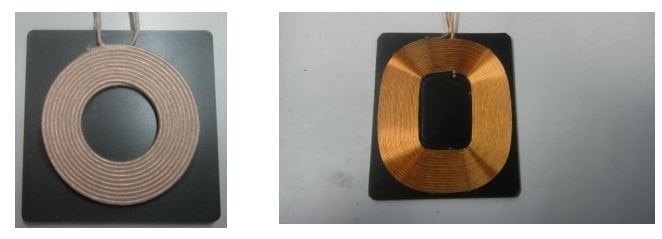
Figure 1: Wireless charging coils
Source: Avnet
How does wireless charging work for EVs?
Wireless EV charging is an enhanced version of smartphone charging, with several differences that allow electric vehicles to charge their batteries without the need for a physical connection. EV charging requires much higher voltage, power, and amount of energy transferred, making the technology, safety, cost, and environmental challenges much more severe.
Wireless EV charging comes in two forms: static and dynamic. Static wireless charging refers to a method of charging an electric vehicle (EV) by parking it over a charging pad. The pad contains an electromagnetic field that transmits energy to the vehicle's battery, charging it without the need for physical contact or movement. Charging commences by aligning the transmitter with the receiver. Static wireless charging is best implemented in places where EVs are parked for an extended period. The charging time is dependent on the AC power supply, the distance between the receiver and the transmitter, and the size of the pads.
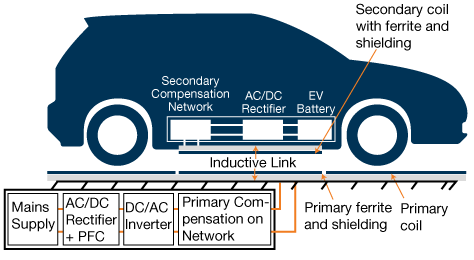
Figure 2: Wireless EV charging system
Source: ElGhanam, Eiman, et al., American Univ. of Sharjah
Figure 2 depicts a block diagram that represents a typical static wireless power transfer (WPT) system. This system is very basic; components and functionality will vary between systems. The primary side comprises an AC/DC rectifier with power factor correction (PFC), an inverter, and a compensation network. The AC power from the mains is first converted to direct current (DC) in order to maximize its real power. The DC is then fed into an inverter and converted to AC at the desired operating frequency. A compensation network is used to control the resonant inductive link. In the vehicle, the coupled AC power is rectified to DC power after some secondary LCC (inductor–capacitor–capacitor) compensation is done, and the DC/DC converter is used to control the output power for charging the EV battery.
Designing wireless charging roads
A Dynamic Wireless Charging System (DWCS), commonly known as on-road charging, is a method of charging an EV while it is moving. A DWCS uses WPT to charge an EV by transferring energy wirelessly from stationary underground transmitter coils to the battery of the vehicle. The underground coils are laid out over long distances under the surface of roads. The battery in the vehicle is able to undergo continuous charging while the vehicle is in motion. DWCS also reduces the need for larger and heavier batteries; the increased availability of chargers means that smaller capacity batteries can be used.
A wireless transmitter pad consists of three parts:
- Coil or conductors
- Shielding material (ferrite/aluminum plate)
- Protective layers
There are two types of transmission coils: single long-coil tracks or segmented-coil arrays made up of sets of transmitter pads buried adjacently. High-voltage AC power is supplied to the coils. When an EV passes over the coils, power is transmitted to the EV via electromagnetic induction. EMF leaks around the system are kept within safety limits with ferrite and aluminum plate shields. The dynamic inductive pad is responsible for the power transmission from the source to the vehicle, making it the most critical part of the system.
Designing a wireless charging road infrastructure involves several key considerations, including charging technology, power transmission, safety, and efficiency. Various configurations exist, including:
- Single Transmitter pad - Single Receiver pad (STSR)
- Multiple Transmitter pads – Single Receiver pad (MTSR)
- Single pad at the Transmitter - Multiple pads at the Receiver (STMR)
- Multiple Transmitter pads – Multiple Receiver pads (MTMR)
These designs are illustrated in Figure 3.
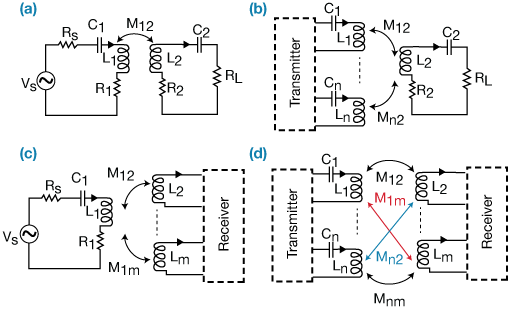
Figure 3: Different ways of connecting pads in dynamic inductive power transfer method- (a) STSR, (b) MTSR, (c) STMR, and (d) MTMR
Source: Eaton
Figure 4 depicts a segmented coil array that is buried below the surface of the road to form the charging track. The array consists of several interconnected coils in parallel or series. With this design, the receiver coil couples with one of the segments in the transmitter array. This ensures that only the transmitter nearest to the receiver is excited. When the vehicle drives away, the segment’s ouput is turned off. This type of system is highly efficient and reduces leakage of the surrounding magnetic field.
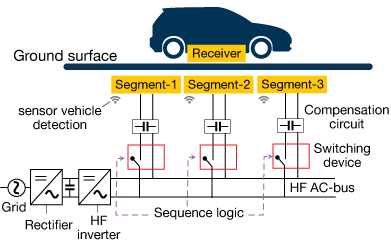
Figure 4: Supply arrangements for the segmented transmitter using a common High-frequency AC-bus
Source: Eaton
What’s the current status of wireless electric roads?
Wireless Electric Road Systems (wERS) have the potential to change how EVs are powered. At present, the technology is in its pilot phase, but engineers and urban planners see it as the future of city transportation. Leading companies in the EV industry, such as Siemens, BMW, WiTricity, Qualcomm, and Evatran Group, are working towards commercial implementation of wERS.
Pilot projects are underway in Europe, Asia, and the United States. Electreon, a leading in-road EV charging technology provider, has successfully demonstrated an electric road system based on inductive technology. The first EV charging road available to the public in the United States is expected to be built near Michigan's historic Central Station.
Electreon has also announced the launch of the “Arena of the Future” project in Italy. The company has demonstrated its proprietary wireless technology, charging a small car and a large electric bus, both equipped with Electreon’s vehicle-side “receiver” that transfers the energy required to charge and travel. Figure 5 shows the preparation of the road for inductive power transfer to charge EVs on the move.
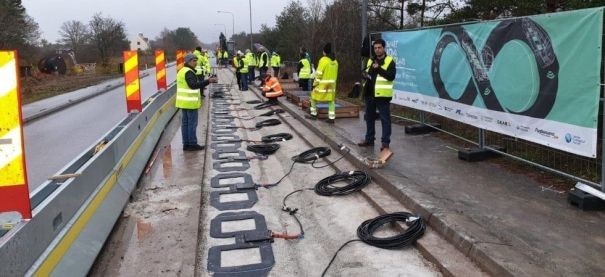
Figure 5: Installing wireless charging pads underground
Source: Electreon Wireless
Summing up: Charging your EV while driving it
As the automobile industry makes a shift towards green energy, several issues must be addressed. One major issue concerning EVs is range; a typical range of 200 miles per charge is not sufficient for long-distance trips. One solution is to increase the capacity of the already large and heavy battery; however, wireless chargers capable of charging an in-motion vehicle could be a more effective solution. While integration of charging coils into roadways is a long and expensive proposition, the investment could pave the way for a more rapid transition to EVs.
Click here for more information about EV Charging.
How will the availability of roads that have wireless charging capability change the design of an EV?
Please tell us in the Comments section below.
